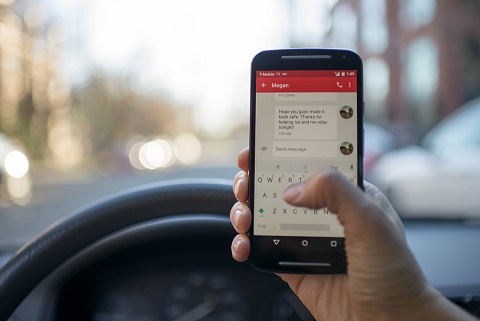According to the National Safety Council, everyday at least nine people die and 100 more are injured on American roads due to distracted driving crashes. Cell phones, dashboard touchscreens, voice command and other in-vehicle technologies pose a threat to our safety.
Three Types of Distractions:
Traffic safety experts classify distractions into three main types: Manual, Visual and Cognitive.
Manual Distraction is when the driver takes one or both hands off the wheel for any reason. Some examples include eating and drinking, adjusting parts of the vehicle or trying to get something from a purse, wallet or briefcase.
Visual Distraction occurs when a driver looks at anything other than the road ahead, even for a split second. This could be looking at a child in the back seat, viewing a new text message on their phone or looking at something on the side of the road.
Cognitive Distractions are ones that keep your mind from being focused during driving. This leads to potential accidents because you aren’t in the right state of mind to think fast or drive safety. Examples could be emotional stress, lack of sleep, talking to someone else or using the phone.
Distracted Driving Facts:
- In 2015 in the United States, the National Highway Traffic Safety Administration (NHTSA) estimated that 660,000 drivers were using electronic devices while driving during the daytime
- 40,000 estimated fatalities in 2017, a 6% increase from 2015
- Handheld cell phone use continues to be the highest among teenage drivers
- Teenagers are 400% more likely to get into an accident from texting
- The Insurance Institute for Highway Safety (IIHS) reports that the fatal crash rate per mile for teenagers is nearly three times the rate for drivers ages 20 and over.
- The average amount of time a driver takes to type out a text message is 5 seconds. If you’re driving 55 mph and look down to text for 5 seconds, you’ve already driven the length of a football field
- 520 pedestrians were killed by distracted drivers in the United States in 2014.
Distracted driving occurs in workplaces as well since employees in all types of industries spend part of their workdays driving. Rushing to get to their next destination in time while thinking about work or using a cell phone makes a collision even more likely. According to the Network of Employers for Traffic Safety, on average, a non-fatal injury crash at work that involves distraction costs the employer $72,442.
What’s the Solution?
Enough people die in car accidents each year to wipe out the population in just two human life cycles—with distracted driving being a major contributor to those deaths. Many companies and state governments are racing to determine the solution to distracted driving—apps that reward you for not using your phone while behind the wheel, cars that block cell phone signals and rising fines for cell-phone-use citations.
But many experts agree that the beginning of a distracted driving solution is the drivers themselves. Our culture has become deeply obsessed with technology and our phones. Learning to curb those impulses, whether it be turning your phone off or placing it in the backseat, can train drivers to get into the habit of leaving their phones alone while operating a motor vehicle. Additionally, safety experts urge parents to set a good example by disregarding their phones while their children are in the car.

